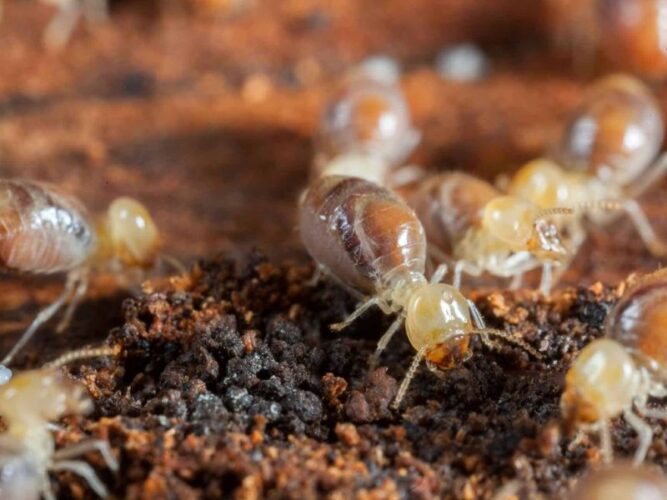Termite infestations can be a nightmare for homeowners, causing structural damage and compromising the safety of your living space. When faced with a termite problem, seeking professional termite treatment is crucial to eliminate these destructive pests.
However, once the treatment is completed, a common question arises: how long should you wait before moving back into your home? In this article, we will explore various factors that influence the wait time and provide guidelines to ensure a safe reentry into your termite-free abode.
What is Termite Treatment?
Termite treatment refers to the application of specific methods and techniques to eradicate termites from a property. Professional exterminators employ a range of strategies to eliminate termites, including chemical barriers, baiting systems, and localized spot treatments.
These treatments target the termites directly, disrupt their colonies, and prevent further infestations.
Types of Termite Treatment
Depending on the extent of the infestation and the demands of your home, several termite treatments may be appropriate. Termite treatments such as fumigation, heat, and liquid termiticides are widespread. Since there are pros and downsides to each approach, it’s best to get advice from an expert on which one might work best in your case.
The Impact of Termite Treatment on Your Home
The Effectiveness of Termite Treatment
Termite treatments are quite efficient in getting rid of termites and preventing future damage to your house. However, results may differ according to the nature of the infestation, the quality of the treatment, and how thoroughly it was applied.
Expert termite exterminators have what it takes to eradicate the problem once and for all.
Safety Considerations
During termite treatment, safety precautions are essential to protect both the occupants of the home and the environment.
The chemicals used in termite treatments are generally safe for humans and pets when applied according to professional guidelines. However, it is crucial to follow any specific instructions provided by the exterminator to minimize potential risks.
Factors Affecting the Wait Time
Type of Termite Treatment Used
The wait time before reentering your home after termite treatment can vary depending on the type of treatment applied. Some treatments may require longer periods for the chemicals to dissipate or for baiting systems to take effect.
Your termite specialist will provide you with specific instructions on when it is safe to return.
Severity of Termite Infestation
The severity of the termite infestation also plays a role in determining the wait time. If the infestation was extensive and required more aggressive treatment measures, additional time may be necessary to ensure the complete eradication of the termites and the restoration of your home’s safety.
Construction Materials and Home Structure
The construction materials and structure of your home can influence the wait time after termite treatment. Certain materials may absorb the treatment chemicals differently, which could affect the time required for dissipation.
Additionally, the complexity of your home’s structure might necessitate longer treatment and inspection periods.
Environmental Conditions
Environmental conditions, such as temperature and humidity, can impact the efficacy of termite treatment. Higher temperatures, for instance, can accelerate the dissipation of chemicals. Similarly, humid conditions might affect the performance of baiting systems.
Exterminators take these factors into account when advising on the appropriate wait time.
Recommended Wait Time After Termite Treatment
The recommended wait time before moving back into your home after termite treatment can vary depending on the factors discussed above. Typically, the waiting period ranges from 24 to 72 hours.
However, it is crucial to follow the specific instructions provided by your termite specialist, as they will consider the unique aspects of your treatment and infestation.
Signs Your Home is Safe to Reenter
Before moving back into your home, it is essential to ensure that it is safe and free from any remaining termite activity. Here are some signs indicating that your home is ready for reentry:
Absence of live termites: A thorough inspection should confirm the absence of live termites or termite damage.
Lack of odor: Foul or unusual odors, often associated with termite infestations, should be absent.
Structural integrity: Your home should exhibit no signs of compromised structural integrity due to termite damage.
Clearance from the exterminator: Obtain clearance from the termite specialist confirming the successful completion of the treatment.
Precautions to Take Before Moving Back In
While the termite treatment has effectively eliminated the termites, it’s important to take some precautions before moving back into your home:
Cleaning: Thoroughly clean your living space, removing any residue or debris from the treatment process.
Ventilation: Open windows and doors to facilitate air circulation and dissipate any remaining chemicals.
Inspect for damage: Check your belongings, furniture, and fixtures for any potential damage caused by the termite infestation.
Address repairs: If necessary, undertake any repairs or maintenance work to restore your home’s condition.
Conclusion
In order to protect your property from the devastating effects of termites, it is essential to have them exterminated. To guarantee your safety and the therapy’s efficacy, you should wait the recommended amount of time after the treatment before returning.
A reasonable waiting period may be determined by thinking about the treatment method employed, the extent of the infestation, the building materials, and the surrounding environment. Getting back inside your termite-free house will go more smoothly if you follow the advice of your professional and take the essential measures.

